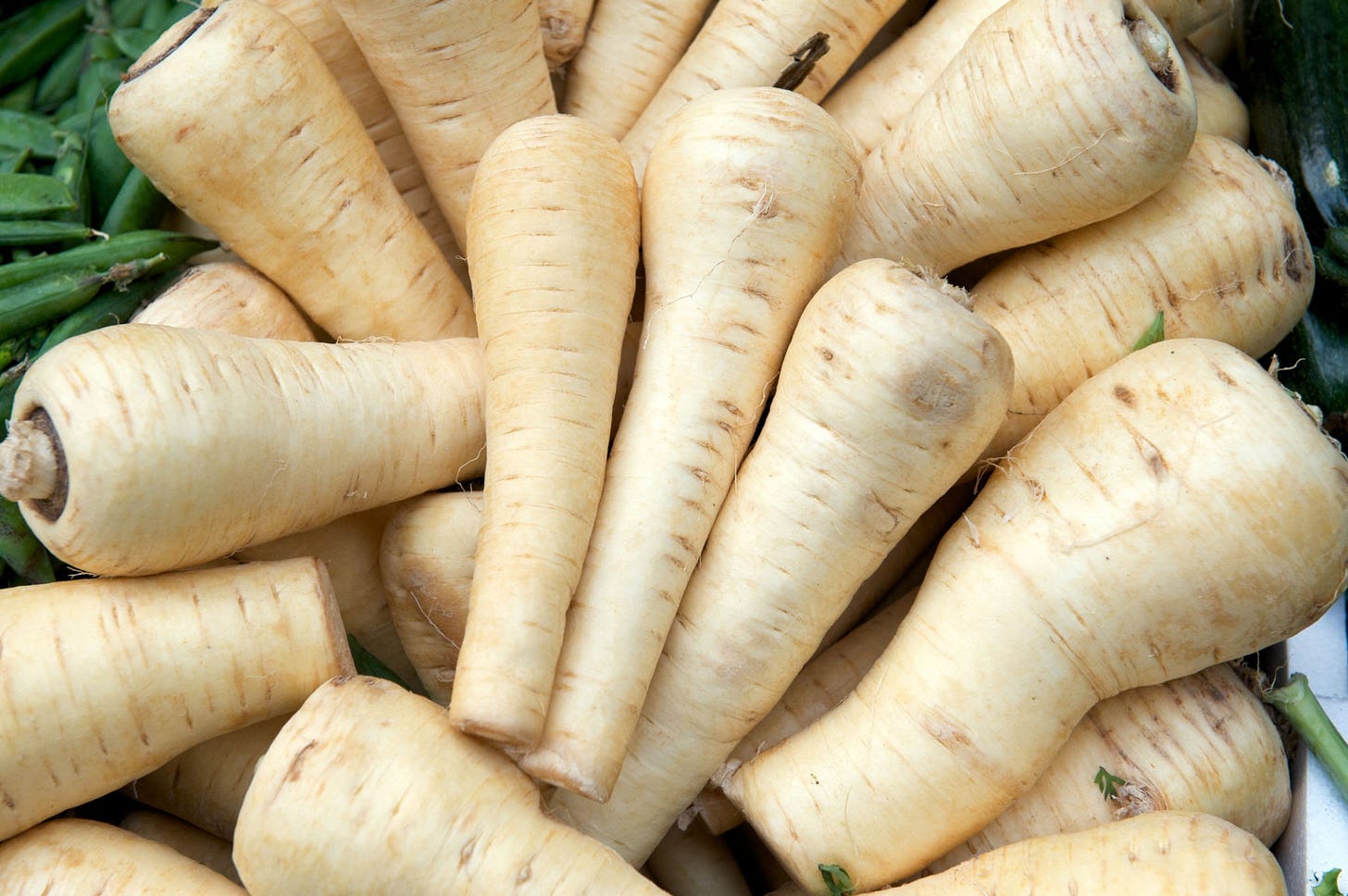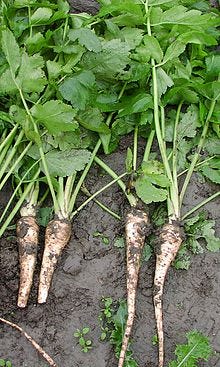A fortune could be made, I reckon, with dictionaries that helped English-speaking tourists navigate menus and food shopping abroad, organised like a graph. You’d drop your finger down a list of words in the language of the country you’re in - parallel columns of French, Italian, Greek, Turkish, Spanish, for instance, in the ‘Europe’ edition - to find the puzzling dish named on the menu. Then you run it across to the side column that translates it into English. Personally, I’d find it particularly helpful with varieties of fish. I can barely distinguish between sea bream and sea bass in my own language, let alone in a foreign one.
There are words for food abroad that no matter how hard I try, I can never remember their meaning. Panais is one of them - the French for parsnip.
It seems to me a completely inappropriate descriptive for the root, a name more fitting as the nom de plume of a female writer of erotic fiction. Or of a Greek goddess, provoker of epic wars between ancient civilisations that drags on in iambic trimeters over decades and folios. It’s a word typically French that looks seductive on the page and is surely pronounced pahnayis. No. Remember that French penchant (may as well stick with French) for excess silent letters? It’s panay, a sound over-delicate for a long straggly root that before the discovery of cane sugar was employed as a sweetener
The common parsnip is an ancient root, at least two millenia old, cultivated by the Romans from a vegetable sourced in the region east of the Mediterranean. Emperor Tiberius was so partial to it, he accepted parsnips in part payment by Germany of its taxes to Rome. It was equally respected in the north of Italy, listed as one of the region’s favourite vegetables in the ‘Marvels of Milan’ of 1288 by Bonvesin da la Riva, a notable poet and teacher of grammar to whom one of the first examples of written Lombard language is attributed. Times change. In the index of all of my contemporary Italian cookbooks it does not feature at all.
French colonists took the parsnip to Canada as a valuable starch, but by the mid-19th century it had been replaced by potatoes. In 1859, England’s Royal Agricultural College was determined to improve it. Its cross-breeding of cultivated plants was so successful that ‘Student’, the new cultivar, became the prime variety. These days, ‘Student’ is a ‘heritage’ parsnip and as popular now as then.
Like carrots, parsnips have the lovely ability when slowly and lengthily roasted to squish into a kind of vegetable fudge, sticky and sweet. They’re not bad grated raw in salads, either.
This is the parsnip’s season. Although they’re available throughout the year, somehow they’re a more appropriate autumn/winter vegetable than a summer one. Perhaps it’s their colour, reflective of blank skies not of high temperatures and days throbbing with hot colour. (Actually, this argument doesn’t work if you factor in the beetroot. But we’ll ignore that.)
They’re a root high in vitamins, and in minerals including potassium which is handy for people looking for a good source of that mineral but wary of the high-calorie banana, a prime provider. What with the addition of antioxidants and dietary fibre, the parsnip is a very useful vegetable from a health perspective.
My own admiration has more to do with its versatility. While parsnips are winners when roasted alongside a joint of beef or pork, they marry well with a broad spectrum of flavours, from ginger and apples to rosemary and curry spices in wonderfully warming soups. Mash them up with boiled potatoes to make a change in fluffy topping for shepherd’s or fish pie. Ribbon them with a potato peeler and fry them up in hot vegetable oil or bake them painted with oil on a roasting tray at 180C/350F to create a delicious crisp to nibble with aperitifs, sprinkled with salt. You can even make moist cakes with them, as you might with carrots and courgettes.
If anyone goes ahead with the food dictionary, to enable a reader to cook the following stew, soothing at this chilly time of year and making excellent use of the parsnip, there should be an appendix in the back for cuts of beef in English versus cuts of beef in American.
British:
American:
Serves 8-10
4kg/8.75lbs shin of beef/beef shank on the bone (see the diagrams)
sea salt and freshly ground black pepper
vegetable oil for frying
olive oil
2 carrots, scrubbed and chopped
1 onion, peeled and chopped
1 celery stalk, chopped
1 clove garlic, crushed
400ml/14 fl oz red wine
100ml/3⅓ fl oz port
1 pig's trotter/foot (for body but optional)
300ml/10 fl oz beef stock
425ml/14 fl oz Guinness
Salt and ground white pepper to taste
For the parsnip puree
1kg/2lbs parsnips, peeled and cut into small cubes
2 shallots, peeled and finely chopped
200ml/6¾ fl oz milk
100ml/3⅓ fl oz cream
2 bay leaves
1 tablespoon butter
Juice of ½ lemon
Preheat the oven to 190C/375F.
Trim any excess fat from the meat. Slice the beef into chunks. Season with salt and freshly ground white pepper. Add vegetable oil to a sauté pan and brown them on all sides. Heat a little olive oil in a heavy-based casserole, and sauté the vegetables until softening. Pour in the red wine and port and bubble until the liquid has reduced by half. Add the meat and pig's trotter (if you butcher doesn’t have one, your Chinese supermarket will) and cover with the stock. Bring to the boil, skimming off any scum that rises to the surface, then add the Guinness and season. Crumple up a large sheet of greaseproof/parchment paper, wet it under the tap and squeeze it out the stretch it over the stew and put the lid on the casserole. Transfer to the oven and cook for three hours, or until the meat is tender.
With a slotted spoon, scoop the meat from the pan to a bowl and keep warm. Strain the cooking liquid through a sieve, return it to the pan and bring to a rolling boil. Reduce it until the sauce has thickened and adjust seasoning if necessary. Remove the pig's trotter, reserving its meat for a supper of it on toast, or with coconut sticky rice and sweet-and-sour cabbage. Return the beef to the pan and bake for a further 30 minutes.
Put the parsnips and shallots in a saucepan with the milk, cream and bay leaves and cover with water. Add the butter and lemon juice, season and bring to the boil then reduce the heat and simmer 15-20 minutes. Drain the vegetables, reserving the cooking liquid, and discard the bay leaves. Place the vegetables in a food processor and blend with enough cooking liquid to make a purée the consistency of whipped cream. Season with salt and freshly ground white pepper and keep warm.
Spoon the meat onto warmed plates and serve with the parsnip purée.






How does one slice the beef into chunks if one is starting with a beef shank "on the bone"? If it's an osso bucco cut you're thinking of, I think one would have to saw the beef shanks into appropriately sized pieces rather than simply "slice" them.
Two centuries old? Possibly millennia?